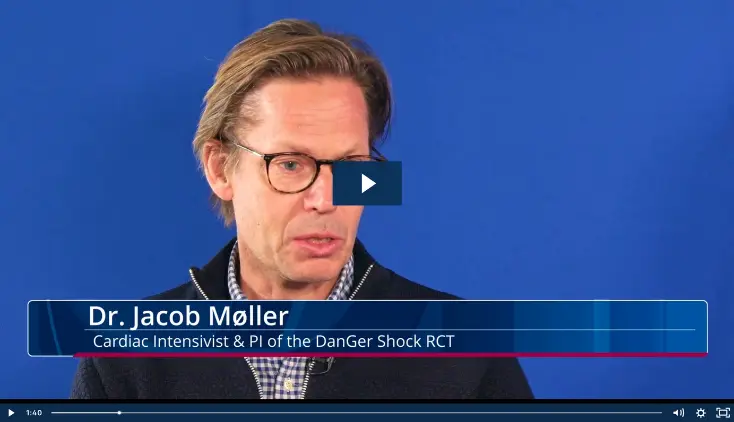AMI Cardiogenic Shock
Timing and Treatment Strategies According to SCAI Classification in Cardiogenic Shock
Giuseppe Tarantini, Giulia Masiero, Holger Thiele, Mario Iannaccone, Benedikt Schrage, Christian Hassager, Felix Woitek, Alaide Chieffo and Jacob Eifer Møller
Key Topics and Take Aways
Tarantini et al. describe a “4 early step” approach for timely management of patients with acute myocardial infarction cardiogenic shock (AMICS), focusing on diagnosis, treatment, prognosis and strategies.
- Early diagnosis of shock severity using SCAI shock stages and phenotypic clusters can help identify patients in whom the risk of disease outweighs the risks of mechanical circulatory support (MCS) devices.
- Timely goals for treatment of AMICS include supporting systemic circulation [door-to-support (DTS)], unloading the left ventricle [door-to-unloading (DTU)] and improving myocardial perfusion and coronary revascularization [door-to-balloon (DTB)].
- Early recognition of modifiers (e.g., age, sex, cardiac arrest ± anoxic brain injury, shock severity, organ failure and/or complications) affects prognosis and therapeutic choices in patients with AMICS.
- Key strategies for managing AMICS include early shock team activation, standardized protocols and training and close collaboration between hub and spoke sites.
In their recently published paper titled “Timing and Treatment Strategies According to SCAI Classification in Cardiogenic Shock,” Giuseppe Tarantini and colleagues describe a “4 early step” approach for timely management of patients with acute myocardial infarction cardiogenic shock (AMICS), focusing on diagnosis, treatment, prognosis and strategies.
- Early diagnosis of shock severity using SCAI shock stages and phenotypic clusters
- Early interventions with support of systemic circulation (DTS), left ventricular unloading (DTU) and improving myocardial perfusion and coronary revascularization (DTB)
- Early recognition of modifiers (e.g., age, sex, cardiac arrest ± anoxic brain injury, shock severity, organ failure and/or complications)
- Early shock team activation, use of standardized protocols and training and close collaboration between hub and spoke sites
The authors explain the importance of accurately assessing patients presenting with cardiogenic shock (CS) to determine their eligibility for percutaneous ventricular assist devices (pVADs). They emphasize using the SCAI shock stages, which enable clinicians to “speak the same language” when assessing patients with cardiogenic shock. They also describe how phenotypic clusters (non-congested vs. cardiorenal vs. cardiometabolic phenotypes) provide additional information about the risk of shock progression and help guide early therapeutic intervention and selection of patients for transfer.
Tarantini et al. explore the goals of supporting systemic circulation [door-to-support (DTS)], left ventricular unloading [door-to-unloading (DTU)] and improving myocardial perfusion and coronary revascularization [door-to-balloon (DTB)]. They write, “Several registry-based studies and meta-analyses of these studies suggest higher survival rates in AMI-CS when an Impella® device is placed before revascularization, rather than in patients where Impella is placed after percutaneous coronary intervention (PCI), although not all.”
The authors discuss several risk modifiers affecting mortality, including non-modifiable factors such as age and sex, as well as factors such as cardiogenic shock etiology, heart rate, systolic blood pressure, glucose, lactate levels, pH and cardiac arrest. They also highlight the impact of organ failure and susceptibility to complications in these patients. “It is of note that most of the risk modifiers might affect each other and promote worse outcomes,” they write.
"Observational data suggest that the presence of a dedicated multidisciplinary shock team has a beneficial impact on in-hospital- and 1-month mortality in patients admitted for CS."
Finally, the authors discuss strategies for early activation of the shock team, interactions between hub and spoke sites, and standardized protocols. They emphasize, “Observational data suggest that the presence of a dedicated multidisciplinary shock team has a beneficial impact on in-hospital- and one month mortality in patients admitted for CS.” They also explain that one of the keys to the success of a hub and spoke model is close collaboration between the sites and the development of joint protocols and training at each site. In addition, they highlight the importance of following protocols when patient transfer is necessary.
Sign Up for Latest Updates
NPS-4063



